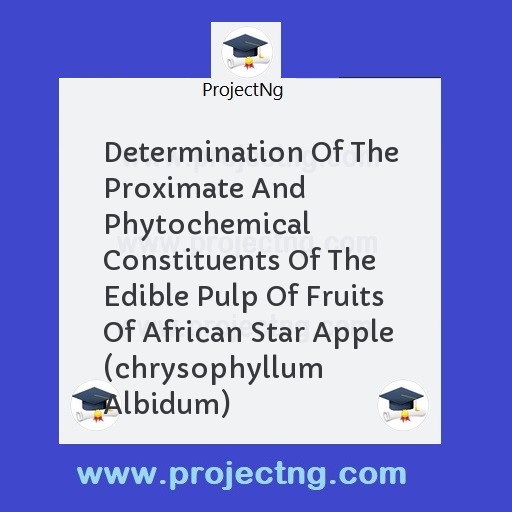Determination Of The Proximate And Phytochemical Constituents Of The Edible Pulp Of Fruits Of African Star Apple (chrysophyllum Albidum)
Science Lab Technology Project Topics
Get the Complete Project Materials Now! »
Abstract
This study set to investigate the proximate and phytochemical contents of edible parts of Chrysophyllum albidum fruit. Methods: The edible parts (fruit-pulp, fruit-skin and seed-shell pericarp) of C. albidum were separated, lyophilized and pulverized into powdered. The edible parts were evaluated for phytochemicals constituents, proximate, fibers, sugars, starch and mineral elements using standard methods. Results: The fruit-skin in comparison with the fruit-pulp and seed shell pericarp had the highest proximate (except for crude fat, crude protein, carbohydrate and moisture); fiber fractions (except lignin), starch, minerals (except for chloride and iron) and phytochemical (except for alkaloids, tannin and vitamin C) values. Fruit-pulp had the highest lignin (3.16 ± 0.07%), iron (7.66 ± 0.02 mg/100 g) and sugar (except arabinose) contents. Seed shell pericarp had the highest chloride (81.28 ± 0.56 mg/100 g), alkaloids (25.80 ± 0.51%), tannin (10.19 ± 0.12%) and vitamin C (0.12 ± 0.01%) contents. Results are significantly (p<0.05) different between samples for sugar, starch, fat, calcium, magnesium, potassium, chloride, alkaloid, tannin and flavonoid contents. The Gas chromatography/Mass spectrometry analysis of n-hexane extract of the edible parts showed the presence of diverse phytochemicals which are mainly of antioxidants and fatty acid origins. Conclusion: The study established that the fruit-skin contained more essential nutrients composition than other samples investigated and with moderate bioactive compounds of diverse purposes.
CHAPTER ONE
INTRODUCTION
Fruits have been shown to be one of the best sources of dietary fiber with lots of vitamins especially C, E and A as well as minerals. Frequent consumption of fruits and vegetables has been associated with a lowered risk of diabetes, hypertension, coronary heart disease, cancer, and stroke .Southon S (2000)]. Fruits give carbohydrates in the form of soluble sugars, cellulose and starch .Nahar N, Rahaman S, Mosiihuzzaman M (1990)] and serve as source of nutrient, appetizer and supplement for food in a world faced with problem of food scarcity.
Chrysophyllum albidum (Linn), also known as African star apple, belongs to the family Sapotaceae , is primarily a forest tree species (Figure 1a) with its natural occurrences in diverse ecozones in Uganda, Nigeria and Niger Republic Bada SO (1997)The fruit (Figure 1b) is seasonal (December-April) and has immense economic potential, especially following the report that jams obtained from the fruit-pulp could compete with raspberry jams and jellies while the oil from the seed has been used for diverse purposes Oladapo MO (2003). In Nigeria, C. albidum is known as ‘‘agbalumo’’ in South Western Nigeria and “udara” in South Eastern Nigeria. Its rich sources of natural antioxidants have been established to promote health by acting against oxidative stress related diseases such as diabetics, cancer
Figure 1: Chrysophyllum albidum tree (A) and fruits (B) [17].
The fruit-pulp has been reported to contain significant amount of ascorbic acid , vitamins, iron and food flavors , fat, carbohydrate and mineral elements Adisa SA (2000) . The fruit-peel has been shown to be a rich source of fiber and mineral Ige MM, Gbadamosi SO (2007) while the seed shell pericarp has been reported to be a good source of carbohydrate and minerals [15]. The fruits are not only consumed fresh but also used to produce stewed fruit, marmalade, syrup and several types of soft drinks Bello FA, Henry AA (2015).
Proximate and photochemical analysis of edible fruits plays a crucial role in assessing their nutritional significance Anthony S (2009) Freeze-drying method is a drying technique considered appropriate for the preservation of nutritional values of the dehydrated products due to the absence of liquid water and the low temperatures required in the process.
In spite of wide application of C. albidum plant and its great potential as good sources of fiber and carbohydrate, information on the fiber fractions and sugar contents of its edible parts seems to be scanty in the available literature has not been fully investigated. This study was designed to evaluate phytochemical constituents of C. albidumfruit. The results of this study may provide useful information on its nutritional potential and contributionves to nutrient intake of the nation. It may also create public awareness of its utilization when in season.
Aim and Objective of the Study
The study was set to determine the proximate and phytochemical constituents of chrysophyllum abidum.
Be the First to Share On Social

Enjoying our content?
Don't miss out on new videos! Subscribe to our YouTube channel for more awesome content.
Subscribe Now!













